The benefits of economic activity in Williston are leveraged by the Town to achieve the goals of this Comprehensive Plan, while the burdens and impacts are managed to ensure that all people in Williston experience it as a livable place. The negative impacts of concentrated economic activity in Taft Corners are mitigated.
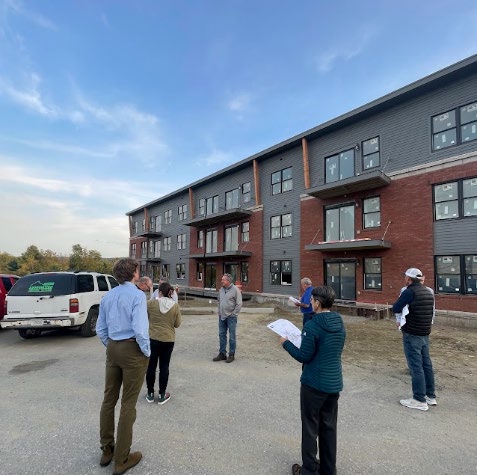
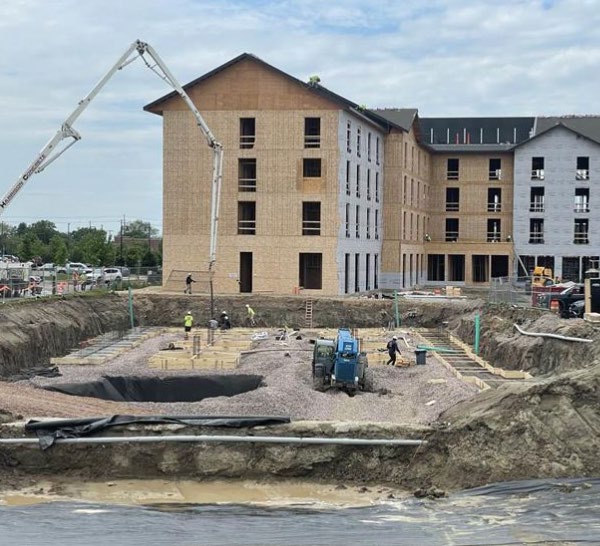
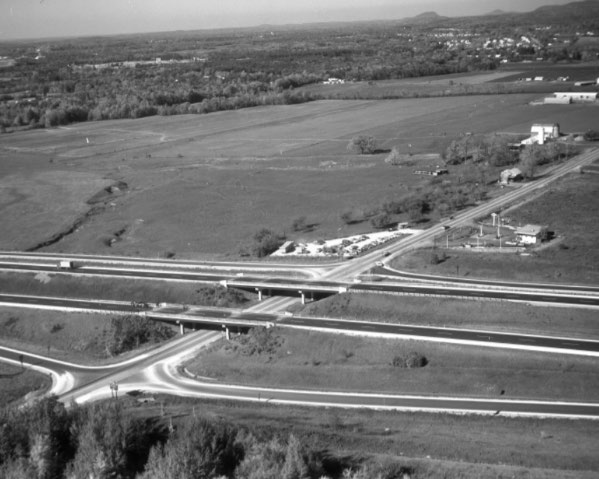
Chapter 4
Economic Development
Introduction
Goals: In 2050, Williston is...
Livable
...because the negative impacts of its economy are reduced and its benefits enhanced- and shared more broadly with its people. Traffic impacts have been mitigated due to investments in sustainable transportation infrastructure, for both vehicles and people. Public safety and emergency services have grown to efficiently cover new needs. The vibrant and varied commercial activity contributes positively to the built environment, strengthens access to everyday needs, and supports local character by providing a wide, accessible, array of options to work, shop, and socialize.
Resilient
...because of a thriving and diverse economy. The town has an intentional and healthy mix of large retailers and small local businesses, as well as agricultural, industrial and service operations. Buildings in the core of town – shaped by the town's Form Based Code – can adapt to new tenants, economic shifts, and needs, where their previous Big Box Store spaces were inflexible. The diverse range of businesses and commercial spaces protect us from an over-reliance on any one sector and can respond to changing desires of residents and the needs of the region.
Equitable
...because it reduces barriers to participation in the economy. It has commercial spaces for a new business owner, access to transportation options that connect to jobs, and widely available internet and cell service. Economic development is shaped by inclusive policies and community support that allow for many pathways to economic participation and success.
Three Things to Know
WILLISTON PLAYS A LARGE ROLE IN THE ECONOMY OF CHITTENDEN COUNTY AND THE STATE OF VERMONT
Williston's location in the state and the region, along with easy access to Interstate 89, Routes 2 and 2A, and Burlington International Airport have led to the development of a diverse and vibrant mix of retail, commercial, and industrial development in the Town over the last 50 years. There are nearly 12,000 jobs in Williston, more than there are citizens of the Town.
WILLISTON HAS THE HIGHEST VOLUME OF RETAIL SALES OF ANY SINGLE MUNICIPALITY IN VERMONT
In 2021 there were over 450 million dollars in taxable retail and service sales in Williston, 50 million dollars more than the next town, (Colchester) and more than 100 million dollars more than any other municipality in the state.
WILLISTON'S ECONOMY IS DEPENDENT ON WORKERS WHO CANNOT AFFORD TO LIVE IN WILLISTON
Most people who work in Williston cannot afford to live in Williston. This is especially true in the retail and service sectors, which are the prime generators of the local option sales tax revenue that keeps municipal taxes relatively low in Williston.
Three Things Public Engagement Told Us
WILLISTON'S PEOPLE VALUE THE VIBRANCY AND CONVENIENCE OF WILLISTON'S ECONOMY
Throughout the public engagement process for this plan, people noted that Williston was a convenient place to live because of the goods and services made readily available by its economy.
WILLISTON'S PEOPLE VALUE THE REDUCTION IN PROPERTY TAXES THEY ENJOY DUE TO RETAIL ACTIVITY IN TOWN
Economic activity in Williston reduces municipal property taxes and makes the Town a more affordable place to own property.
WILLISTON'S PEOPLE WANT TO SEE AN EXPANSION OF OPPORTUNITY FOR SMALL BUSINESSES IN TOWN
When asked about what should change in Williston's economy, people most often said that they wanted to see more opportunities for small, local businesses to play a role.
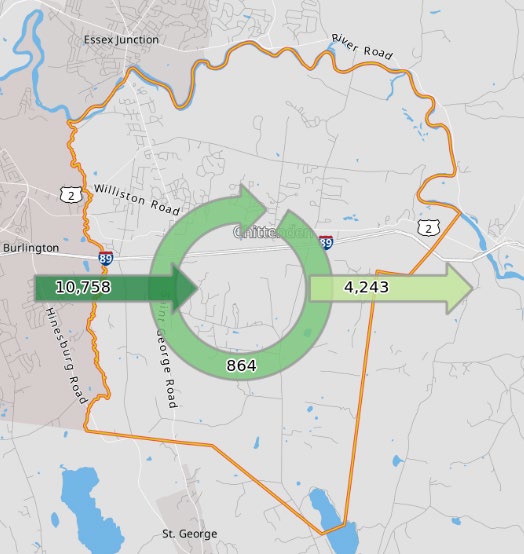
Figure 1: Map showing the inflow of people who work in Williston but live elsewhere (dark green arrow) and the outflow of people who live in Williston and work elsewhere (light green arrow). From U.S. Census Bureau, Census on the Map.
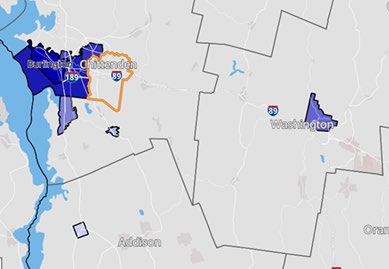
Figure 2: Map showing where people in Williston commute to work.
Table 1: Employment by Sector, 2000-2020 | ||||||||||
|---|---|---|---|---|---|---|---|---|---|---|
Industry<br/>2000 | Establishments<br/>2010 | Establishments<br/>2015 | Establishments<br/>2020 | Establishments<br/>2000 | % Change<br/>2010 | Employment (Number of jobs)<br/>2015 | Employment (Number of jobs)<br/>2020 | Employment (Number of jobs) | Employment (Number of jobs) | % Change |
Natural Resources and Mining | 3 | 5 | 4 | 5 | 66.70% | 17 | 22 | 23 | 30 | 76.50% |
Construction | 75 | 86 | 88 | 80 | 6.70% | 1,178 | 984 | 1,182 | 1,242 | 5.40% |
Manufacturing | 30 | 32 | 31 | 35 | 16.70% | 1,115 | 576 | 1,273 | 629 | -43.60% |
Wholesale Trade | 67 | 88 | 82 | 82 | 22.40% | 852 | 758 | 704 | 842 | -1.20% |
Retail Trade | 96 | 106 | 102 | 98 | 2.10% | 1,596 | 2,299 | 2,147 | 1,832 | 14.80% |
Transportation and Warehousing | 25 | 33 | 34 | 36 | 44% | 594 | 914 | 1,070 | 1,053 | 77.30% |
Information | 15 | 20 | 22 | 20 | 33.30% | 479 | 296 | 302 | 286 | -40.30% |
Financial Activities | 42 | 53 | 55 | 58 | 38.10% | 488 | 515 | 795 | 519 | 6.40% |
Professional and Business Services | 117 | 160 | 206 | 241 | 106.00% | 1,319 | 1,286 | 1,819 | 1,756 | 33.10% |
Education and Health Services | 53 | 50 | 56 | 66 | 24.50% | 834 | 756 | 822 | 1,010 | 21.10% |
Leisure and Hospitality | 23 | 40 | 46 | 55 | 139.10% | 310 | 862 | 886 | 801 | 158.40% |
Other | 64 | 54 | 54 | 59 | -7.80% | 479 | 273 | 378 | 315 | -34.20% |
Government | 20 | 20 | 26 | 25 | 25% | 463 | 1,098 | 1,604 | 1,315 | 184% |
TOTAL | 630 | 747 | 806 | 860 | 36.70% | 9,724 | 10,639 | 13,005 | 11,629 | 19.60% |

Objectives, Strategies and Actions
Objectives
Economic development in Williston contributes to its resilience by increasing the diversity of types, scales, and intensities of economic activity in the Town.
Economic activity in Williston is scaled appropriately in concert with Williston's land use goals, while allowing for flexibility for landowners and businesses.
A greater proportion of the workforce in Williston is able to live in Williston and benefit from the Town's status as a hub of economic activity in the region.
The Town's transportation infrastructure supports economic development and resiliency. Specific strategies and actions are in Chapter 10 Transportation.
The Local Option Sales Tax remains a stable component of Williston's municipal revenue stream, allowing the Town to invest in achieving its Comprehensive plan goals.
Strategies
Refine emergency services to address the impacts of greater economic activity.
Ensure that desired economic activity in Williston is adequately supported by infrastructure, capacity allocation, and services.
Encourage residential development in Taft Corners, which will support small businesses.
Ensure that needed infrastructure is not in conflict with land use and economic development goals.
All existing and future development within the designated Growth Center should be exempted from Act 250 jurisdiction, as per Act 181 (H.687) passed by the Vermont State Legislature in 2024.
Build out Taft Corners in a manner that is consistent with the Taft Corners Vision Plan and encourage phased rather than scatter-shot development.
Play an active role in the physical development of Williston's most economically productive lands.